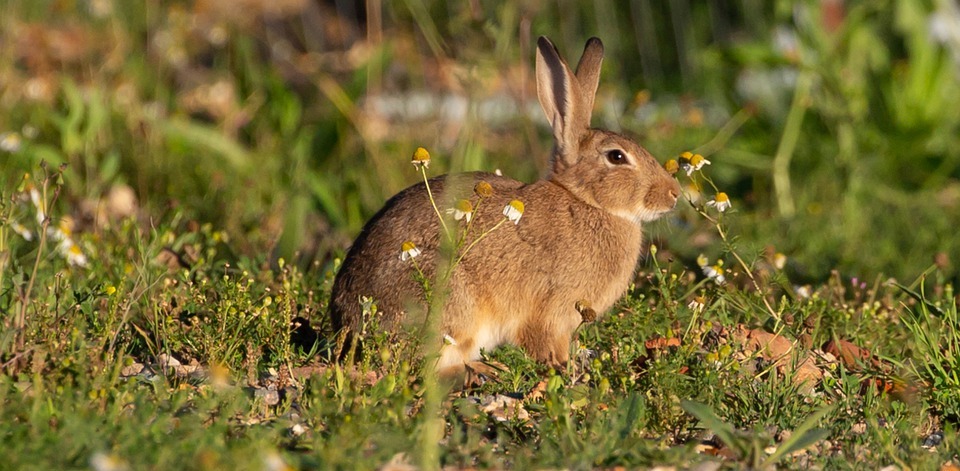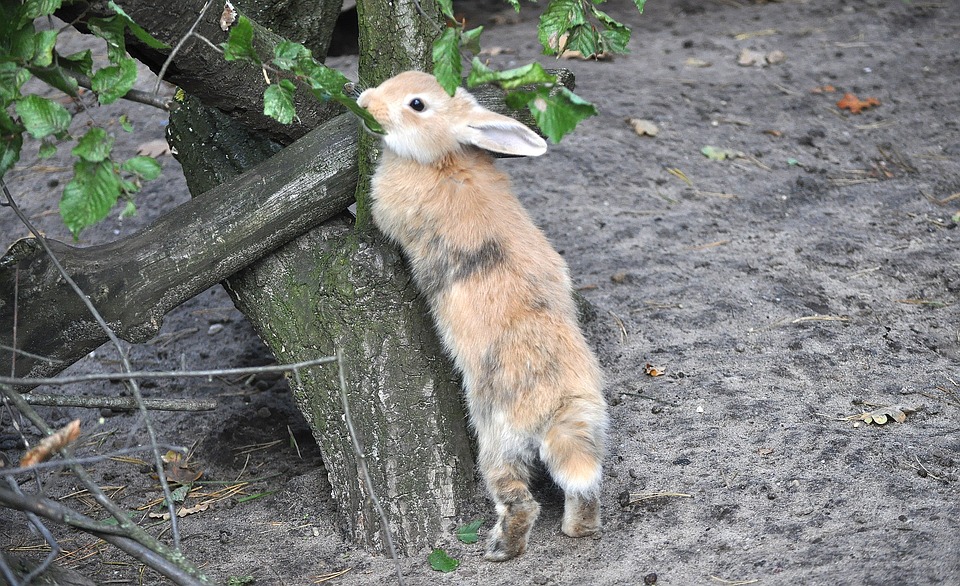This article dives into the fascinating world of rabbits and their incredible adaptations for surviving the harsh conditions of winter. We will explore their winter habits, including where they seek shelter, how they stay warm, and what they eat. We will also discuss the challenges they face during this time of year and how they cope with the threat of predators, shedding light on the remarkable resilience of these small mammals.
Part 1: Navigating the Winter Landscape

1.1 Winter Habitat Selection
Rabbits are highly adaptable creatures, but their winter survival hinges on choosing suitable habitats that offer protection from the elements and predators.
1.1.1 The Importance of Cover
Dense Vegetation: Areas with dense vegetation, such as hedgerows, thickets, or coniferous forests, provide valuable cover for rabbits, shielding them from harsh winds and snow.
Burrow Network: A network of interconnected burrows offers multiple escape routes and safe havens for rabbits, particularly during periods of heavy snowfall.
Elevated Terrain: In areas prone to flooding, rabbits may choose habitats on higher ground, minimizing the risk of being submerged during winter storms.
1.2 Winter Home: The Burrow
The burrow is the heart of a rabbit's winter survival strategy. It provides a safe haven from predators, harsh weather, and extreme temperatures.
1.2.1 The Burrow's Structure
Multiple Entrances: A typical rabbit burrow has multiple entrances, allowing for escape routes and ventilation.
Nesting Chamber: A designated nesting chamber, often lined with soft materials like grass and fur, serves as a cozy retreat for the rabbit.
Escape Tunnels: Underground tunnels connect the various entrances, creating a labyrinthine network that allows rabbits to evade predators.
1.2.2 Burrow Maintenance
Regular Cleaning: Rabbits keep their burrows clean and dry, removing any debris or waste that could attract predators or parasites.
Seasonal Adjustments: They may expand their burrows during winter, adding extra chambers or tunnels to accommodate the increased need for shelter.
Part 2: Keeping Warm in Winter

2.1 The Power of Fur
Rabbits rely heavily on their fur to stay warm during the winter months.
2.1.1 Winter Coat Growth
Denser Fur: As the days shorten and temperatures drop, rabbits grow a thicker and denser coat of fur, providing excellent insulation against the cold.
Seasonal Change: The winter coat is typically darker than the summer coat, offering camouflage against the snowy landscape and providing an extra layer of protection.
Moult Cycle: The moult, or shedding process, takes place in the spring and autumn, ensuring the rabbit has the appropriate fur coat for the season.
2.2 Behavioral Adaptations
Rabbits employ a range of behaviours to maintain their body temperature during winter.
2.2.1 Huddling Together
Collective Warmth: Rabbits may huddle together in their burrows, particularly during very cold nights, sharing body heat to stay warm.
Family Groups: Huddling is often seen in family groups, with adults protecting their young from the cold.
2.2.3 Shivering
Involuntary Muscle Contractions: When temperatures plummet, rabbits may shiver, an involuntary muscle contraction that generates heat.
Energy Conservation: Shivering is an energy-intensive process, and rabbits generally rely on other strategies like fur and huddling to conserve energy.
Part 3: Finding Food in Winter's Grip
3.1 Winter Diet Challenges
Rabbits are herbivores, and their primary food source during warmer months is fresh grasses and herbs. Winter presents significant challenges for these small mammals as their usual diet becomes scarce.
3.1.1 Adapting to Scarcity
Browsing Behaviour: Rabbits become more selective in their winter diet, browsing on twigs, bark, and buds of deciduous trees and shrubs.
Bark Preferences: They often favour willow, birch, and poplar trees, as these species have a higher nutritional content during winter.
Food Availability: The availability of these winter foods can vary depending on the region and the severity of the winter.
3.2 The Importance of Stored Food
While not all rabbits actively store food, some may stash away food in their burrows during the autumn months, providing a crucial resource during leaner times.
3.2.1 Foraging Strategies
Autumn Preparation: Rabbits that practice food storage may collect and cache grasses, herbs, and even bark in their burrows during the fall.
Retrieving Food: They access these stores throughout the winter, supplementing their diet when fresh food is scarce.
3.3 Winter Foraging Strategies
Rabbits adapt their foraging behaviour to the harsh conditions of winter.
3.3.1 Adaptable Diets
Dietary Shifts: As the winter progresses and fresh food becomes increasingly scarce, rabbits may supplement their diet with non-traditional food sources like fallen fruit, berries, and even fungi.
Nutrient-Rich Foods: They often select food sources that are high in moisture and fibre, such as bark and buds, to maintain hydration and energy levels.
3.3.2 Foraging in Snow
Snow-Covered Landscapes: When snow covers the ground, rabbits may need to dig through the snow to access food sources, using their strong front paws and sharp teeth.
Following Trails: They may follow animal trails or paths created by humans to reach areas where food is more readily available.
Part 4: Facing Winter's Predators
4.1 Predator Threats
Rabbits face a constant threat from predators throughout the year, but these threats intensify during winter.
4.1.1 Increased Vulnerability
Winter Foraging: Rabbits are more vulnerable during winter due to their restricted movement and increased foraging activity, which exposes them to predators.
Reduced Cover: Snow cover can diminish natural cover, making rabbits more visible to predators.
4.1.2 Common Predators
Birds of Prey: Owls, hawks, and falcons are active predators of rabbits, using their keen eyesight to spot prey from above.
Canids: Coyotes, foxes, and wolves are common predators of rabbits, particularly in areas where they are abundant.
Felids: Domestic and wild cats, including bobcats and lynx, may prey on rabbits, especially during times of food scarcity.
4.2 Defensive Strategies
Rabbits have developed a number of adaptations and strategies for avoiding predators.
4.2.1 Sharp Senses
Alertness: Rabbits are highly alert animals, constantly scanning their surroundings for signs of danger.
Hearing: They have excellent hearing, enabling them to detect the faintest sounds of approaching predators.
Smell: Their strong sense of smell helps them identify predators from afar.
4.2.2 Escape Strategies
Rapid Running: Rabbits are known for their speed and agility, enabling them to outrun most predators.
Zigzagging: They use zigzagging movements and sudden changes in direction to confuse predators.
Leaping: They can leap high, jumping over obstacles to evade predators.
4.2.3 Burrow Protection
Safe Haven: Burrows provide a safe haven from predators, especially during winter when snow cover may restrict access to other shelters.
Escape Routes: Multiple entrances and tunnels in burrows allow rabbits to escape quickly if a predator enters their burrow.
Part 5: The Impact of Human Activity
5.1 Habitat Loss
Urbanization: Rapid urbanization and development often lead to the loss of rabbit habitats, reducing their available living space.
Agriculture: Large-scale agriculture can fragment habitats, making it more difficult for rabbits to find suitable areas for living and foraging.
5.2 Predation Pressure
Domestic Cats: Domestic cats are known to prey on wild rabbits, and their presence can impact rabbit populations in urban and suburban areas.
Hunting and Trapping: Hunting and trapping of rabbits can also have a significant impact on their populations, especially in areas where these practices are common.
5.3 Disease and Parasites
Disease Transmission: Human activity can contribute to the spread of diseases among rabbits, particularly in areas with high population densities.
Parasite Introduction: Contact with domestic animals or contaminated environments can introduce parasites that can harm wild rabbit populations.
Part 6: Helping Rabbits Through Winter
6.1 Providing Shelter
Rabbit Hutches: If you have pet rabbits, ensure their hutches are well-insulated and protected from the elements.
Winter Shelter: Consider providing additional shelter, such as a straw-filled box or a heated pad, to help rabbits stay warm.
Natural Cover: Creating or maintaining hedgerows, thickets, and other natural cover in your garden can provide refuge for wild rabbits.
6.2 Supplying Food
Winter Diet: Offer a variety of fresh vegetables and hay to supplement their diet.
Water Source: Provide a constant source of fresh water, ensuring it doesn't freeze.
Wild Rabbits: Avoid placing food out for wild rabbits unless you are experienced in wildlife rehabilitation, as this can potentially disrupt their natural foraging behaviour.
6.3 Maintaining Health
Regular Checkups: Take your rabbits for regular checkups to ensure their health and identify any potential problems.
Preventive Measures: Consult with your veterinarian about vaccinations and deworming for rabbits.
Disease Prevention: Ensure proper hygiene in and around your rabbit's living area to prevent the spread of diseases.
Part 7: FAQs
7.1 Where do wild rabbits go during winter?
Wild rabbits typically stay in their burrows during the winter, using them for shelter from the cold, wind, and snow. They may expand existing burrows or dig new ones for better protection.
7.2 How do rabbits survive the winter without fresh grass?
Rabbits adapt to the lack of fresh grass by browsing on twigs, bark, and buds of deciduous trees and shrubs. They may also rely on stored food if they had the opportunity to gather it in the fall.
7.3 Do rabbits hibernate in the winter?
Rabbits do not hibernate in the traditional sense. However, they may become less active during very cold periods, spending more time in their burrows and conserving energy.
7.4 Can rabbits survive in freezing temperatures?
Rabbits can tolerate freezing temperatures to a certain extent, but prolonged exposure can be fatal. They rely on their thick winter coat, burrowing, and huddling behaviour to stay warm.
7.5 Are rabbits more susceptible to predators in the winter?
Yes, rabbits are more vulnerable to predators in winter because they are less active and their movements are restricted by snow. Predators may also be more active during winter due to food scarcity.
7.6 What can I do to help wild rabbits survive the winter?
You can provide food and shelter for wild rabbits by leaving out fresh vegetables and hay, and ensuring they have access to a sheltered area. However, it's important to consult with a wildlife expert before providing assistance to ensure it is safe and effective.
Everyone is watching
-

Do Rabbits Lay Eggs? (The Surprising Truth)
OTHER TYPES OF PETSThis article will unravel the common misconception that rabbits lay eggs, exploring the fascinating world of r...
-

What's a Group of Rabbits Called? (A Comprehensive Guide)
OTHER TYPES OF PETSThis article delves into the fascinating world of rabbits, exploring the various terms used to describe a grou...
-

Can Rabbits Eat Grapes? A Guide to Safe Rabbit Treats
OTHER TYPES OF PETSThis comprehensive guide will explore the safety and suitability of grapes for rabbits, providing detailed inf...
-

Predators That Hunt Rabbits: A Guide to Natural Enemies
OTHER TYPES OF PETSI've always been fascinated by the circle of life, that delicate dance between predator and prey. Growing up ...
-

Are Rabbits Nocturnal Animals?
OTHER TYPES OF PETSThe question of whether rabbits are nocturnal animals is a fascinating one, with a surprisingly complex answer...
